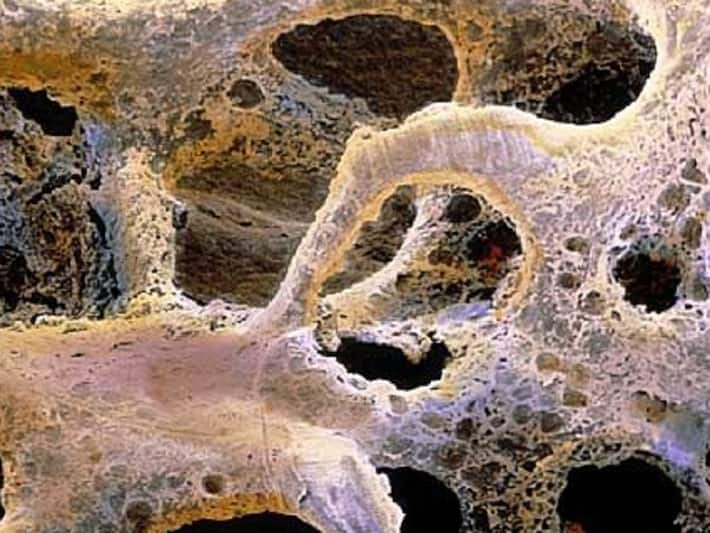Bone cancer
Bone cancer can arise in any of the bones of the body but it is most commonly seen in the long bones of the arms and legs. It has the ability to attack the body within the first 20 years of life when maximum growth in the musculoskeletal system takes place.
Primary bone cancers originate in the bone tissue. Common types are osteosarcoma, chondrosarcoma and Ewing sarcoma. Other rare bone cancers include fibrosarcoma, leiomyosarcoma, malignant fibrous histiocytoma, angiosarcoma and chordoma. Secondary bone cancer occurs when cancer cells from other parts of the body migrate to the bone tissue. High dose radiotherapy, Paget’s disease, rare inherited genetic disorders such as Li-Fraumeni syndrome, hereditary multiple exostoses (HME) and hereditary retinoblastoma increase the chances of developing primary bone cancers.
Types
There are different types of cancers identified by the organ or tissue that it originates from. As the name suggests, bone cancer simply means cancer that originates in the bone. Bone cancer can arise in any of the bones of the body but it is most commonly seen in the long bones of the arms and legs. They are broadly classified into
Primary bone cancer is further categorized into:
Apart from the above three types, other rare bone tumors include –
Causes
Although the exact cause of bone cancer is not yet known, it is thought to be related to changes taking place in the bones during their growing phase. Cancer develops due to an abnormal cell that either has some genetic alterations or is damaged due to external factors. The abnormal cell multiplies out of control to form a tumor or may migrate to other parts of the body. Here are a few factors that increase the risk of developing primary bone cancers:
Symptoms
There is an evident lack of awareness and understanding about bone cancers in the public domain, which is often the main reason for its delayed diagnosis. Because people hardly know about bone cancers, the initial signs and symptoms are often neglected. Plus, bone cancers markedly differ from other cancers in their nature, distribution and prognosis. Therefore, the associated signs of cancer are not totally the same as seen in other cancers. The first sign of bone cancer in children is painful bones and joints, which is easily mistaken for minor sporting injury or growing teenager pain. If this sign goes unnoticed it may worsen with time and significantly reduce survival rates.
So, if you or your child experiences the following symptoms persistently, do not ignore. Seek medical help immediately.
These signs may also develop due to other conditions. It is advisable to consult a physician for confirmed diagnosis.
Diagnosis
Diagnostic tests include blood test to determine alkaline phosphatase level, Magnetic Resonance Imaging (MRI) and biopsy.
Alkaline phosphatase test:
Initially, the doctor may suggest a few laboratory tests. In India, alkaline phosphatase test is a key test for detecting bone cancers. Alkaline phosphastase is chemical substance that is particularly present in higher concentrations in the blood in the presence of highly active bone-forming cells. A positive test indicates abnormal bone tissue.
Imaging test
Biopsy:
Biopsy of the suspected tissue is crucial for definite diagnosis. A small sample of the tissue is removed from the body and is examined under the microscope to detect abnormal cells. Biopsy is also used to confirm the stage and grade of cancer by analyzing the features of abnormal cells.
Treatment
In the past, the only available option to treat bone cancer was to surgically remove the affected limb. With growing technological advances and development in health care, bone cancer surgeries are carried out in 90% of patients worldwide without the need to amputate the limb.
Since bone cancers mainly affect children, pediatric oncologists face several challenges in the treatment of bone cancers. This is because bone cancer treatment involves radiation therapy, surgery and chemotherapy that can have an adverse effect on the growth and development of children.
The treatment is decided depending on various factors such as the type of primary bone cancer, its exact location, the stage and grade of cancer, the extent of reach and the size of tumor, and the overall general health of the patient. Also read Latest advances in cancer treatments
Radiotherapy is a treatment which involves the use of high-energy radiation beams targeting cancerous tissue or tumor. The high radiation beam damages the DNA of abnormal cells rendering them incapable to multiply. The only disadvantage is that radiation also harms surrounding healthy cells. However, healthy cells are resilient and can recover fully whereas cancer cells are sensitive to radiation and get killed rapidly. Read more about radiotherapy. In the treatment of bone cancer, radiation therapy is used:
Chemotherapy involves use of chemical drugs/anti-cancer drugs targeted to kill rapidly growing cancer cells. Usually a combination of drugs is administered. Since anti-cancer drugs target only fast growing cells, without distinguishing between normal and abnormal cells, other rapidly growing healthy cells of the body, such as hair follicle cells, are also attacked which results in side-effects. Read more about chemotherapy side-effects. Chemotherapy may be used in bone cancer treatment the following reasons:
Bone cancer surgery is aimed at removing the entire tumor and probably some affected bone tissues surrounding the tumor. It is extremely challenging because if some cancer cells or a part of tumor is left behind after the surgery, it may grow and spread eventually. A limb sparing surgery means surgical intervention without amputating the limb. In severe cases, amputation may be necessary.
Bone cancer treatment in India
In India, bone cancer surgery is very common because of the increased success rate. Today India has emerged as one of the crucial centers for bone cancer surgery. The availability of good treatment facilities and experienced cancer surgeons has even attracted international patients for surgical treatment.
Here’s a list of leading hospitals in India that provide bone cancer treatment:






0 Comments